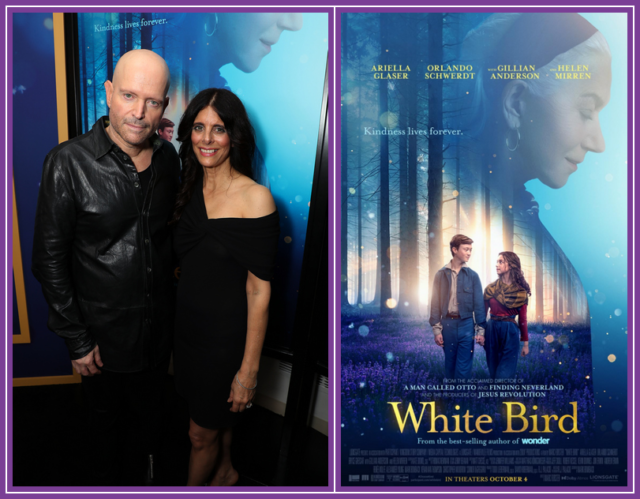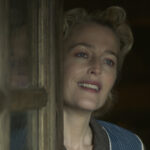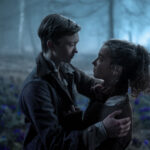
An insightful exclusive interview with director MARC FORSTER and executive producer RENEE WOLFE discussing the exquisite and beautifully poignant WHITE BIRD, a film that will touch your soul.
SYNOPSIS: From the best-selling author of “Wonder”, the book that sparked a movement to “choose kind,” comes the inspirational next chapter. In White Bird, we follow Julian (Bryce Gheisar), who has struggled to belong ever since he was expelled from his former school for his treatment of Auggie Pullman. To transform his life, Julian’s grandmother (Helen Mirren) finally reveals to Julian her own story of courage — during her youth in Nazi-occupied France, a boy shelters her from mortal danger. They find first love in a stunning, magical world of their own creation, while the boy’s mother (Gillian Anderson) risks everything to keep her safe. From director Marc Forster (Finding Neverland and Christopher Robin), screenwriter Mark Bomback, and based on R.J. Palacio’s book, White Bird: A Wonder Story, like Wonder before it, is an uplifting movie about how one act of kindness can live on forever.
Directed by MARC FORSTER and written by Mark Bomback based on the book “White Bird: A Wonder Story” by R.J. Palacio, WHITE BIRD stars Ariella Glaser, Orlando Schwerdt, Bryce Gheisar, with Gillian Anderson, and Helen Mirren, and is produced by Todd Lieberman, p.g.a., David Hoberman, p.g.a., and R.J. Palacio, and executive produced by RENEE WOLFE, among others
There aren’t enough words to describe the power and emotion that director MARC FORSTER (Christopher Robin, A Man Called Otto)delivers with WHITE BIRD. This story has never been more timely than it is today given the current global geopolitical climate. A coming-of-age tale and a story of first love and true friendship set during the Holocaust, in addition to opening our eyes to the power of kindness, WHITE BIRD aims to educate younger generations about the Holocaust and foster empathy. Supported by the producing team behind Wonder, Todd Lieberman and David Hoberman, along with Forster’s production partner RENEE WOLFE, not to mention Forster’s long-time collaborators, cinematographer Matthiias Koenigswieser, editor Matt Chesse, and production designer Jennifer Williams, among others, WHITE BIRD is a “companion piece” to Wonder. Thanks to the impeccable casting of Ariella Glaser as young Sara and Orlando Schwerdt as her friend Julien, their chemistry carries the story of Sara’s youth and how she was saved by Julien and his family, drawing us in ever deeper with emotion. Your heart won’t be the same after watching WHITE BIRD. Building on the performances of Glaser and Schwerdt is the meticulously crafted film’s visuals, including the stunning metaphor of the forested location and heavy mist symbolizing protection. Koenigswieser’s visuals are beautifully drawn with a great attention paid to lighting and contrast, providing a delicacy that speaks to the blossoming friendship and young love of Sara and Julien. Thanks to Jennifer Williams, the production design shooting location in the Czech Republic was carefully curated to match historical accuracy, enhancing the story’s impact.
(Photos courtesy of Lionsgate Studios)
In this exclusive interview with MARC FORSTER and RENEE WOLFE, we dive into some of the key elements that let WHITE BIRD take flight, among them:
- the origin of the story and RJ Palacio’s graphic novel
- working closely with production designer Jennifer Williams to carefully select and curate the filming locations in the Czech Republic, adjusting them as needed to match the historical French architecture
- locations as “a character in and of themselves,” making them a vital part of shaping the emotional and narrative experience for the audience
- the casting of Ariella Glaser, who comes from a well-educated Jewish family and understands the historical context which was crucial in anchoring the emotional authenticity of the character of Sara
- finding actors who could portray the historical context and significance of the Holocaust story, particularly for the younger audience; ensuring the young actors had strong chemistry, as this was crucial for the romantic love story between the characters; the on-screen chemistry between Glaser and Schwerdt
- the importance of the educational aspect in developing the project; recognizing the need to educate younger generations about the Holocaust and its far-reaching impact.so as to inspire dialogue and understanding, particularly with younger audiences
- the emotional depth and visual storytelling as intentional choices by the filmmakers to capture the resilience, imagination, and hope of the young characters amidst the darker historical events
- visual storytelling and choice of locations in “White Bird” contribute to the film’s emotional impact and message
- the power of visual storytelling; visual and tonal aspects; using locations, cinematography, and production design to enhance the emotional depth and impact of the story
- connecting with the human experience; the importance of seeing and hearing stories of others and how this can enrich on’e own life and perspective; focusing on personal experiences and relationships of the characters
- the benefit of the pandemic lockdown experience as it deepened the filmmakers’ connection to the themes of isolation and resilience in the story, and influenced their creative approach to the production
- lessons learned by RENEE WOLFE; even with limited resources, they were able to create something artistically meaningful and proud of
- lessons learned by MARC FORSTER; gaining hope from working with the young cast, believing there will be light at the end of the tunnel and that the next generation can learn from the past to ensure such tragedies do not happen again
- and more!
TAKE A LISTEN. . .
by debbie elias, exclusive interview 09/18/2024
.
WHITE BIRD is in theatres on October 4, 2024




















